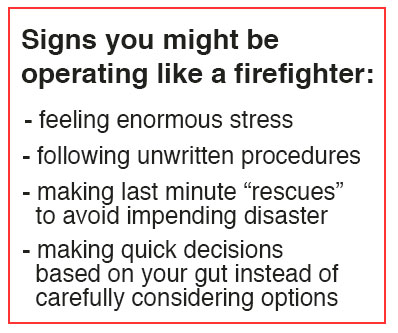Planning Your Ecommerce Strategy = Less Fires, Increased Profit
Did you dream of being a firefighter when you were a child? Or did you look at firefighters with awe and wonder?
You probably didn’t know then that firefighters are underpaid considering what they do. Unsurprisingly, firefighters also suffer enormous stress – the career has been named the most stressful one of 2015.
We assume if you are reading this you aren’t in fact paid to be a firefighter, so why do so many ecommerce owners spend all their time putting out fires?
One of the big pitfalls in the fast-moving world of ecommerce is to fall into a “put out the fire” mindset. In a small to medium sized shop, people are multi-tasking, handling a wide range of responsibilities to keep the business running. It’s very easy to fall into reactivity. This leads to missed revenue opportunities, avoidable problems and unnecessary stress.
 It doesn’t have to be like this. Ecommerce business owners do not need to be firefighters. By strategically planning ahead, you can reduce the fires you have to deal with and focus on the strategic business of increasing profit.
It doesn’t have to be like this. Ecommerce business owners do not need to be firefighters. By strategically planning ahead, you can reduce the fires you have to deal with and focus on the strategic business of increasing profit.
The most successful ecommerce shops are run by mindful and proactive owners who are not caught in the tyranny of the moment. Instead of spending all their time putting out fires, these shops have a strategic plan and the support of key partners throughout the year.
What Ecommerce Strategy Looks Like During the Year
Strategic planning means taking time to envision your business’ desired future, setting goals and determining the steps to reach them. For a retailer whose business culminates during the holidays, ecommerece strategy means carefully answering questions similar to the following in order to plan ahead.
Quarter 1 (Q1)
- Did we hit our numbers last year? What is our current state of the business on all key performance indicators? What do our analytics tell us?
- What are our goals for this upcoming year? What needs to happen differently from last year?
- What is our marketing, sales and engagement plan for this upcoming year to reach those goals?
- What events do we need to plan for this year?
- What attention does our website require this year thinking about mobile, high volume times, future-readiness, and so on?
- Would it be a good time to take a vacation and recover from the holidays?
Two successful ecommerce retailers we know consistently plan ahead, particularly to take advantage of opportunities around events throughout the year.
Arccos Golf, makers of technology that tracks golf performance, coordinates their promotions with events to drive enormous amount of traffic to their website arccosgolf.com.
“We actually plan our entire release cycle around major golfing events,” shared Ben Heller, Director of Software Development at Arccos. “This coincides with major PR pushes with in both digital and traditional media, usually coupled with a deep discount on our core product. This drives enormous amounts of traffic to our website leading up to and through the duration of each event.”

Arccos Golf is growing quickly with strategic partnerships and promotions coordinated with major golf events.
A popular site for wall art, greatBigcanvas.com capitalizes on events such as the Pantone Color of the Year announcement release each December. The marketing and technology teams coordinate ahead of time so they can create content and push out specials on social media within hours of the announcement each year.
“When a lot of eyes are looking at the same place, it’s an opportunity,” explained Gavin Jocius, greatBIGcanvas’ data-driven marketing strategist we recently interviewed. “But it doesn’t have to be the Superbowl. There are smaller events relevant to your target audiences that you can anticipate and plan for.”
Note that in both cases, time is spent planning ahead of time to create an effective campaign around response to events instead of last-minute reaction.

The marketers at GreatBIGcanvas.com plan promotions around events important to target audiences such as interior designers.
Quarter 2 (Q2)
Questions to consider:
- How is our progress toward our goals?
- What adjustments are needed?
Your business web site is a living thing that is constantly growing and changing and responding to user activity. This means you can’t just set a strategic plan early in the year without being open to adjustment.
Greg Lellouche, founder and CEO of No Man Walks Alone, runs a successful online men’s shop focused on craftsmanship. His team digs deeps to find consensus on strategy in terms of direction and magnitude. They also know that adjustments are required over the long-term.

No Man Walks Alone is run by a small team so their planning isn’t an overly formalized exercise. However, they do make sure they find team consensus on direction and plan months in advance.
“Think carefully about all the tools you need, such as the software and other technology that you will be using,” recommends Lellouche. “But also leave some room to change your mind and adapt as you start using them. Nothing beats going through the processes and steps required to run your business, to understand what tools you really need and where to expend resources and time to improve.”
Regular, dedicated time for planning can help you to fine-tune and adapt to new information.
“We reflect on where we are as a business quarterly, about a week after every board meeting,” explains Heller of Arccos.
“Our CEO processes feedback from the meeting and sits down with the entire company to discuss. Everyone from the newest intern to our VPs weighs in with their thoughts and opinions. It’s informal, but very open and honest.”
The Arccos marketing team has found that promotions are a way to take-charge to attract more customers.
“Our promotions, fueled by some paid media and our own social media, have been very successful in moving us to a more proactive stance,” explained Vice President of Marketing for Arccos, Stephanie Boms. “Now we are working on executing a content strategy with the goal to increase qualified traffic to our site.”
Quarter 3 (Q3)
Questions to consider:
- How is our progress toward our goals?
- What adjustments are needed?
- What do we need to do for the holidays in Q4?
Holidays, holidays, holidays – we can’t say it enough – Q3 should be focused on preparing for the holidays.
Ideally ecommerce retailers would be doing things such as:
- stress-testing for holiday traffic spikes to make sure your hosting is sufficient
- conducting user research and/or testing for any new features or changes
- making sure you have an emergency plan in place if your site goes down or has a critical issue
- determining marketing and engagement plans during the holiday season, for example, competitive shipping, highlighting top grossing categories, developing a gift guide. Read more details on these revenue-producing ideas here.
“Be sure to not only focus on the user experience and brand/product presentation, but also focus on the back end part of the site,” recommends Boms of Arccos. “Set up things like state tax and shipping options early so your developers can build that in to your platform and communicate effectively to consumers.”
Do not go to your development team in Q4 about a change you need for the holiday season.
You are likely to be disappointed because what you want to happen can’t be executed and tested properly in the time frame you need. And Q4 is not a time for hurried work or executing a half-baked plan. If your site experiences technical problems or goes down during holiday shopping season, the revenue consequences can be tremendous.

August is a great time to talk with your development team about your ecommerce strategy for the holidays.
Quarter 4 (Q4)
By now, you shouldn’t be thinking about the big picture but executing your plan, tracking your data and being ready for any fires. For most ecommerce firms, Q4 is not a time for major changes or big projects.
“We don’t have 15 minutes to spare in Q4,” explained Joicus of greatBIGcanvas. “I know ecommerce people who make sure their kids aren’t born in Q4 because it’s so hard to take any time off at all.”
Q4 is the World Series or March Madness time for ecommerce retailers – it’s time to show your stuff and execute well. The extra effort you’ve put into planning your ecommerce strategy should pay off with higher traffic and conversions as well as great customer experiences. Q4 should be less about putting out fires and more about jumping on opportunities if you’ve done your work in Q1-Q3.
How Your Development Team Fits into Your Ecommerce Strategy
Your development team helps you execute the technical aspects of your strategic plan and avoid as many fires as possible.
We believe that for ecommerce sites that don’t have an in-house development team, a retainer agreement with a development firm is a key component to success. Retainer agreements align our teams and encourage all of us to have an overarching plan. Each month a number of development hours are devoted to improving your website. See an example of a proactive development project that is saving thousands of dollars for a Boston-based client. Time set aside for planning combined with your development retainer agreement encourage you to take care of important items before a crisis hits.
Time set aside for planning combined with your development retainer agreement encourage you to take care of important items before a crisis hits.
Common “emergencies” we hear about in the world of ecommerce are:
- Traffic spikes and other hosting related issues
- Unforeseen bugs and glitches that affect check out
- Uncontrollable changes to third party apps that impact your site
The reality of an ecommerce shop is that there are sometime unavoidable fires that occur that require you to put on a firefighter’s hat and call for help. For example, Paypal recently changed their API, and all of our clients who used a certain Paypal product needed to have their sites updated. With a dev team on call who knows your site, this can be a quick and easy change. But seeking out a new dev team and updating them on all of this on the fly is a big challenge.
Also critical is having a scalable hosting plan that can dedicate additional resources as needed. The best situation is if you have a development shop who can also host your website. Because we are familiar with clients’ sites and how they are setup, we are in a position to know their hosting needs well. We can allot resources where necessary and adjust for planned events. For example, for a big email blast, we can devise a plan to stagger the mailing if this would be beneficial for site load.
To be successful and sustainable in the long term, you need an ecommerce strategy and the right people to help you execute it.
Put away the firefighter hat. Get that strategic plan in place and find those partners who support you in proactively planning instead of only putting out fires.
